International Journal of Image, Graphics and Signal Processing @ijigsp
Статьи журнала - International Journal of Image, Graphics and Signal Processing
Все статьи: 1146
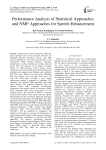
Performance analysis of statistical approaches and NMF approaches for speech enhancement
Статья научная
Super-Gaussian Based Bayesian Estimators plays significant role in noise reduction. However, the traditional Bayesian Estimators process only DFT spectral amplitude of noisy speech and the phase is left unprocessed. While deriving Bayesian estimators, consideration of phase information provides improved results. The main objective of this paper is twofold. Firstly, the Super-Gaussian based Complex speech coefficients given Uncertain Phase (CUP) based Bayesian estimators are compared under different noise conditions like White noise, Babble noise, Pink noise, Modulated Pink noise, Factory noise, Car noise, Street noise, F16 noise and M109 noise. Secondly, a novel speech enhancement method is proposed by combining CUP estimators with different NMF approaches and online bases updation. The statistical estimators show less effective results under completely non-stationary assumptions. Non-negative Matrix Factorization (NMF) based algorithms show better performance for non stationary noises. The drawback of NMF is, it requires training and/or requires clean speech and noise signals. This drawback can be overcome by taking the advantages of both statistical approaches and NMF approaches. Such approaches like Posteriori Regularized NMF (PR-NMF), Weibull Rayleigh NMF (WR-NMF), Nakagami Rayleigh (NR-NMF), CUP estimator with Gamma and Generalized Gamma distributions + NMF + Online bases Update (CUP-GG + NMF + OU) and CUP-GG + WR-NMF / NR-NMF + OU are considered for comparison. The objective of this paper is to analyze the performance of speech enhancement methods using Bayesian estimators, NMF approaches, Combination of statistical and NMF approaches. The objective performance measures Perceptual Evaluation of Speech Quality (PESQ), Short-Time Objective Intelligibility (STOI), Signal to Noise Ratio (SNR), Signal to Distortion Ratio (SDR), Segmental SNR (Seg SNR) are considered for comparison.
Бесплатно
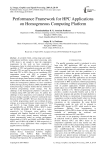
Performance framework for HPC applications on homogeneous computing platform
Статья научная
In scientific fields, solving large and complex computational problems using central processing units (CPU) alone is not enough to meet the computation requirement. In this work we have considered a homogenous cluster in which each nodes consists of same capability of CPU and graphical processing unit (GPU). Normally CPU are used for control GPU and to transfer data from CPU to GPUs. Here we are considering CPU computation power with GPU to compute high performance computing (HPC) applications. The framework adopts pinned memory technique to overcome the overhead of data transfer between CPU and GPU. To enable the homogeneous platform we have considered hybrid [message passing interface (MPI), OpenMP (open multi-processing), Compute Unified Device Architecture (CUDA)] programming model strategy. The key challenge on the homogeneous platform is allocation of workload among CPU and GPU cores. To address this challenge we have proposed a novel analytical workload division strategy to predict an effective workload division between the CPU and GPU. We have observed that using our hybrid programming model and workload division strategy, an average performance improvement of 76.06% and 84.11% in Giga floating point operations per seconds(GFLOPs) on NVIDIA TESLA M2075 cluster and NVIDIA QUADRO K 2000 nodes of a cluster respectively for N-dynamic vector addition when compared with Simplice Donfack et.al [5] performance models. Also using pinned memory technique with hybrid programming model an average performance improvement of 33.83% and 39.00% on NVIDIA TESLA M2075 and NVIDIA QUADRO K 2000 respectively is observed for saxpy applications when compared with pagable memory technique.
Бесплатно

Performance of Personal Identification System Technique Using Iris Biometrics Technology
Статья научная
The Iris identification as one of the significant techniques of biometric identification systems s and iris recognition algorithm is described. Biometric technology advances intellectual properties are wanted by many unauthorized personnel. As a result many researchers have being searching ways for more secure authentication methods for the user access. Iris recognition uses iris patterns for personnel identification. The system steps are capturing iris patterns; determining the location of iris boundaries; converting the iris boundary to the stretched polar coordinate system; extracting iris code based on texture analysis. The system has been implemented and tested using dataset of number of samples of iris data with different contrast quality. The developed algorithm performs satisfactorily on the images, provides 93% accuracy. Experimental results show that the proposed method has an encouraging performance.
Бесплатно
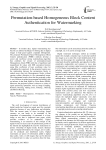
Permutation-based Homogeneous Block Content Authentication for Watermarking
Статья научная
In modern days, digital watermarking has become an admired technique for hitting data in digital images to help guard against copyright infringement. The proposed Permutation-based Homogeneous Block Content authentication (PHBC) methods develop a secure and excellence strong watermarking algorithm that combines the reward of permutation-based Homogeneous block (PHB) with that of significant and insignificant bit values with X0R encryption function using Max coefficient of least coordinate value for embedding the watermark. In the projected system uses the relationship between the permutation blocks to embed many data into Homogeneous blocks without causing solemn distortion to the watermarked image. The experimental results show that the projected system is very efficient in achieving perceptual invisibility with an increase in the Peak Signal to Noise Ratio (PSNR). Moreover, the projected system is robust to a variety of signal processing operations, such as image Cropping, Rotation, Resizing, Adding noise, Filtering , Blurring and Motion blurring.
Бесплатно
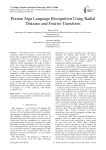
Persian Sign Language Recognition Using Radial Distance and Fourier Transform
Статья научная
This paper provides a novel hand gesture recognition method to recognize 32 static signs of the Persian Sign Language (PSL) alphabets. Accurate hand segmentation is the first and important step in sign language recognition systems. Here, we propose a method for hand segmentation that helps to build a better vision based sign language recognition system. The proposed method is based on YCbCr color space, single Gaussian model and Bayes rule. It detects region of hand in complex background and non-uniform illumination. Hand gesture features are extracted by radial distance and Fourier transform. Finally, the Euclidean distanceis used to compute the similarity between the input signs and all training feature vectors in the database. The system is tested on 480 posture images of the PSL, 15 images for each 32 signs. Experimental results show that our approach is capable to recognize all 32 PSL alphabets with 95.62% recognition rate.
Бесплатно
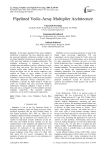
Pipelined Vedic-Array Multiplier Architecture
Статья научная
In this paper, pipelined Vedic-Array multiplier architecture is proposed. The most significant aspect of the proposed multiplier architecture method is that, the developed multiplier architecture is designed based on the Vedic and Array methods of multiplier architecture. The multiplier architecture is optimized in terms of multiplication and addition to achieve efficiency in terms of area, delay and power. This also gives chances for modular design where smaller block can be used to design the bigger one. So the design complexity gets reduced for inputs of larger number of bits and modularity gets increased. The proposed Vedic-Array multiplier is coded in Verilog, synthesized and simulated using EDA (Electronic Design Automation) tool - XilinxISE12.3, Spartan 3E, Speed Grade-4. Finally the results are compared with array and booth multiplier architectures. Proposed multiplier is better in terms of delay and area as compared to booth multiplier and array multiplier respectively. The proposed multiplier architecture can be used for high-speed requirements.
Бесплатно
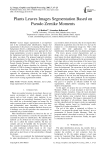
Plants Leaves Images Segmentation Based on Pseudo Zernike Moments
Статья научная
Leaves images segmentation is an important task in the automated plant identification. Images leaf segmentation is the process of extracting the leaf from its background, which is a challenging task. In this paper, we propose an efficient and effective new approach for leaf image segmentation, we aim to separate the leaves from the background and from their shadow generated when the photo was taken. The proposed approach calculates the local descriptors for the image that will be classified for the separation of the different image's region. We use Pseudo Zernike Moments (PZM) as a local descriptor combined with K-means algorithm for clustering. The efficient of PZM for features extraction lead to very good results in very short time. The validation tests applied on a variety of images, showed the ability of the proposed approach for segmenting effectively the image. The results demonstrate a real improvement compared to those of new existing segmentation method.
Бесплатно
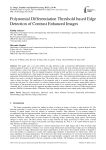
Polynomial Differentiation Threshold based Edge Detection of Contrast Enhanced Images
Статья научная
This paper uses a two-step method for edge detection using a polynomial differentiation threshold on contrast-enhanced images. In the first step, to enhance the image contrast, the mean absolute deviation and harmonic mean brightness values of the images are calculated. Mean absolute deviation is used to perform the histogram clipping to restrict over-enhancement. First, the clipped histogram is divided in half, and then two sub-images are created and equalized, and combined into a final image that keeps image quality. The second phase involves edge detection using a polynomial differentiation-based threshold on contrast-improved visuals. The polynomial differentiation curve-fitting method was used to smooth the histogram data. The nearest index value to zero is utilized to calculate the threshold value to detect the edges. The significance of the proposed work is to contrast enhancement of low-light images to extract the edge lines. Its value or merit is to achieve improved edge results in terms of various image quality metrics. The findings of the proposed research work are to detect the edges of low-contrast images. Image quality metrics are computed and it is observed that the suggested algorithm surpasses former methods in respect of Edge-based contrast measure (EBCM), Performance Ratio, F-Measure, and Edge-strength similarity-based image quality metric (ESSIM).
Бесплатно
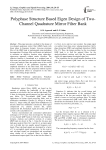
Polyphase Structure Based Eigen Design of Two-Channel Quadrature Mirror Filter Bank
Статья научная
This paper presents a method for the design of two-channel quadrature mirror filter (QMF) banks with linear phase in frequency domain. Low-pass prototype filter of the QMF bank is implemented using polyphase decomposition. Prototype filter coefficients are optimized to minimize an objective function using eigenvalue-eigenvector approach without matrix inversion. The objective function is formulated as a weighted sum of four terms, pass-band error and stop-band residual energy of low-pass analysis filter, the square error of the overall transfer function at the quadrature frequency and amplitude distortion of the filter bank. The simulation results clearly show that the proposed method requires less computational efforts in comparison to the other state-of-art existing design methods.
Бесплатно
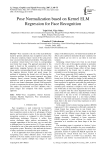
Pose Normalization based on Kernel ELM Regression for Face Recognition
Статья научная
Pose variation is the one of the main difficulty faced by present automatic face recognition system. Due to the pose variations, feature vectors of the same person may vary more than inter person identity. This paper aims to generate virtual frontal view from its corresponding non frontal face image. The approach presented in this paper is based on the assumption of existence of an approximate mapping between the non frontal posed image and its corresponding frontal view. By calculating the mapping between frontal and posed image, the problem of estimating the frontal view will become the regression problem. In the present approach, non linear mapping, kernel extreme learning machine (KELM) regression is used to generate virtual frontal face image from its non frontal counterpart. Kernel ELM regression is used to compensate for the non linear shape of the face. The studies are performed on GTAV database with 5 posed images and compared with linear regression approach.
Бесплатно
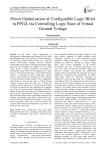
Статья научная
In this article, power optimization is investigated in Configurable Logic Block (CLB) of Field Programmable Gate Array (FPGA) for 65nm technology via controlling Virtual Ground Voltage (Vssv) state that follows Power-Gated standard. Initially different Configurable Logic Block are designed through the logic gates and then expanded via adding Look Up Table circuit (LUT) in inputs; afterwards, the samples of Configurable Logic blocks are investigated in two logic states of Virtual Ground Voltage =0 and Virtual Ground Voltage =1 regarding the power dissipation; whereas 100µs is time reference for simulation of time controller of Virtual Ground Voltage function. First Configurable Logic Block are kept at logic state of Virtual Ground Voltage =1(power gated) for 10µs out of 100µs and remaining time at logic state of Virtual Ground Voltage =0 (power not gated); then the simulation test is repeated up to 50µs in 5 steps for each Configurable Logic Block sample. Finally the result shows that reduction being at logic state of Virtual Ground Voltage =0 in a constant time period has linear effect on decreasing average power. With the Configurable Logic Block in operation for 50% of the total time in Virtual Ground Voltage =1 logic state, the average power reduces up to 49% in the best case scenario. Meanwhile the Configurable Logic Block can still preserve its logic state.
Бесплатно
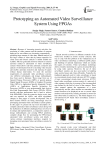
Prototyping an Automated Video Surveillance System Using FPGAs
Статья научная
Because of increasing terrorist activities, the resolution of video cameras and the number of cameras deployed for surveillance are increasing exponentially – producing huge amount of video data. Manual analysis of this large volume of video data by human operators for crime scene and forensic analysis is neither reliable nor scalable. This has generated enormous interest in research activities related to automation of video surveillance systems which allows real-time automatic extraction and analysis of information from live incoming video streams and enables automatic detection and tracking of targets without human intervention. To meet the real-time requirements of automated video surveillance systems, very different technologies and design methodologies have been used in literature. These range from use of General Purpose Processors (GPPs) or special purpose Digital Signal Processors (DSPs) or Graphics Processing Units (GPUs) to Application Specific Integrated Circuits (ASICs) or Applications Specific Instruction Set Processors (ASIPs) or even programmable logic devices like Field Programmable Gate Arrays (FPGAs). FPGAs provide real-time performance that is hard to achieve with GPPs/DSPs, limit the extensive design work, time, and cost required for ASICs, and allow algorithmic changes in later stages of system development. Due to these features FPGAs are being increasingly used for prototyping automated video surveillance system quickly. In this paper we present the top level description of a complete automated video surveillance system along with the elaboration of different challenges/issues involved in its design and implementation, a comparative analysis of design methodologies and existing FPGA platforms, complete design flow for prototyping the FPGA-based automated video surveillance system, and details of various primary input/output interfaces required for designing smart automated video surveillance systems for future.
Бесплатно

Pyramid Image and Resize Based on Spline Model
Статья научная
The paper is based around the formalization of the image model as a linear combination of B-splines, which is close to interpolation. The authors present, on average, its corresponding explicit aspects and low-frequency filtering and scaling operators. The possibility to obtain digital images scaled to an arbitrary, not necessarily integer, number of times is demonstrated in the article and the corresponding algorithm is provided. The article provides with the examples on estimation of the quality of approximation of the indicated spline model. Also there are given grounds for its introduction as an alternative to the well-known image model based on the two-dimensional Gaussian function. It is noted that with the increasing order, B-splines differ little from Gaussian, and their simpler calculation makes the spline model attractive for research and use. Applying the well-known formalization of the approach to the construction of a pyramid of digital images based on Gaussian functions, the authors suggest its extension onto the case of a spline model. The use of image pyramids is conditioned by the task of finding special points in a digital image in order to determine the unambiguous correspondence between the images of the same object in different digital photographs. The paper presents linear operators based on B-splines of 2-6 orders aimed at the construction of a pyramid, it also demonstrates an example of their usage. Based on the convolution of the raster with a mask with variable coefficients the possibility to obtain digital images scaled to an arbitrary, not necessarily integer, number of times is demonstrated in the article and the corresponding algorithm is provided. Image resizing based on the suggested algorithm is also demonstrated by examples. The authors believe that the research conducted in the paper in the future will allow for digital images to obtain more computationally simple algorithms for determining special points and their detectors. Results of paper: 1. The model of a DI has been formalized on the basis of two-dimensional polynomial splines, on the basis of B-splines of the second-sixth orders which are close to interpolation on the average. 2. The convolution operators of low-frequency DI filtering based on the spline model are presented. 3. Provided are the scaling operators used to build image pyramids, in order to further search for special points. 4. An algorithm for scaling the DI to an arbitrary, not necessarily an integer number of times based on a continuous spline approximation has been suggested. 5. Algorithm for scaling a digital image based on a spline model allows you to change the size of the image in any (not necessarily an integer) number of times, differs in that it provides high scaling accuracy and no artifacts due to high approximate properties and smoothness of the spline model;6. The scaling algorithm allows digital image processing at high computational speed due to the optimal computational scheme with a minimum of simpler mathematical operations, compared with models based on the two-dimensional Gaussian function.
Бесплатно
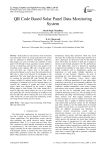
QR Code Based Solar Panel Data Monitoring System
Статья научная
Solar panels are safe and one of the commonly used renewable sources of energy generation now-a-days and are subjected to different atmospheric conditions. Data loggers are used to monitor the condition of solar panels with the help of data acquisition system. Zigbee is used as a transferring solar data from solar panels to the recording system (laptop). QR code is basically used to store and share any content, here in this paper an advanced technique is used to store the solar panel data in QR code in video form followed by developing a web application. This solar panel data can easily be accessed by scanning the generated QR code through QR code scanner installed in android mobile phone. One of the advantages of technique used in this research paper is to visualize the variations of graphs and values of data logger which were displayed on the screen of laptop during online in video format. This video format file is stored in QR code which reduces the size of pre-stored solar panel data file. Second advantage of technique used here that QR code allows reducing the size of pre-stored video format file of solar panel data monitoring system into image format without any loss of data.
Бесплатно

Quadrotor control using advanced control techniques
Статья научная
Control of the quadrotor has been noted for its difficulty as the result of the so-called high maneuverability, exceedingly nonlinear system and strongly coupled multivariable. This work deals with the simulation depend on proposed controllers of a quadrotor that can overcome this difficulty. The quadrotor mathematical model is derived using a Newton-Euler formulation. Three types of controllers are investigated to control and stabilization the position and attitude of quadrotor using feedback linearization. The first controller is Fuzzy-PID, it is considered as a reference benchmark to compare its results with the others two controllers which are PID tuned using GA and ANFIS. The performance of the designed control structure is evaluated through the response and minimizing the error of the position and attitude. Simulation results, shows that position and attitude control using Fuzzy-PID has fast response and better steady state error and RMS error than ANFIS and PID tuned using GA. The all controllers are tested by simulation under the same conditions using SIMULINK under MATLAB2015a.
Бесплатно
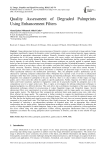
Quality Assessment of Degraded Palmprints Using Enhancement Filters
Статья научная
Image enhancement in the pre-processing stage of biometric systems is a crucial task in image analysis. Image degradation significantly impacts the biometric system’s performance, which occurs during biometric image capturing, and demands an appropriate enhancement technique. Generally, biometric images are mixed with full of noise and deformation due to the image capturing process, pressure with sensor surface, and photometric transformations. Therefore, these systems highly demand pure discriminative features for identification, and the system’s performance heavily depends on such quality features. Hence, enhancement techniques are typically applied in captured images before go into the feature extraction stage in any biometrics recognition pipeline. In palmprint biometrics, contact-based palmprints consist of several ridges, creases, skin wrinkles, and palm lines, leading to several spurious minutiae during feature extraction. Therefore, selecting an appropriate enhancement technique to make them smooth becomes a significant task. The feature extraction process necessitates a completely pre-processed image to locate key features, which significantly influences the identification performance. Thus, the palmprint system’s performance can be enhanced by exploiting competent enhancement filters. Palmprints have reported a lack of novelty in enhancement techniques rather than more centering on feature encoding and matching techniques. Some enhancement techniques in fingerprints were adopted for palmprints in the past. However, there is no clear evidence of their impact on image quality, and to what extent they affect the quality in specific applications. Further, frequency level filters such as the Gabor and Fourier transforms exploited in fingerprints would not be practically feasible for palmprints due to the computational cost for a larger surface area. Thus, it opens an investigation for utilising enhancement techniques in degraded palmprints in a different direction. This work delves into a preliminary investigation of the usage of existing enhancement techniques utilised for pre-processing of contact fingerprint images and biomedical images. Several enhancement filters were experimented on severely degraded palmprints, and the image quality was measured using image quality metrics. The High-boost filter comparatively performed better peak-signal-to-noise ratio, while other filters affected the image quality. The experiment is further extended to compare the identification performance of degraded palmprints in the presence and absence of enhanced images. The results reveal that the enhanced images with the filter that has the highest peak signal-to-noise ratio (High boost filter) only show an increased genuine accept rate compared to the ground truth value. The High-boost filter slightly decreases the system’s equal error rate, indicating the potential of exploiting a pre-enhancement technique on degraded prints with an appropriate filter without compromising the raw image quality. Optimised enhancement techniques could be another initiative for addressing the severity of image degradation in contact handprints. Doing so they could be successfully exploited in civilian applications like access control along with other applications. Further, utilising appropriate enhancement filters for degraded palmprints can enhance the existing palmprint system’s performance in forensics, and make it more reliable for legal outcomes.
Бесплатно
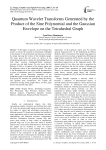
Статья научная
In this paper we present a novel technique that permits to extract the essential on information embedded in the product of sine polynomial and Gaussian envelope by simply knowing the vertices of the tetrahedral graph. The study proves that the matrix of vertices of the tetrahedral graph and its variants are the building block of both Haar wavelets, Hadamard-Walsh transform, wavelets sets and tight frames. We also prove that the Berkeley B Gate is a function of the degree matrix and the adjacency matrix of the tetrahedral graph. The latter is the Hermitian part of the unitary polar decomposition in terms of elementary gates for quantum computation [68] which reveals interesting properties of the tetrahedral graph in both quantum group, Lie group and Pauli group for wavelets sets, quantum image processing and quantum data compression. We explore the connection existing among graphs theory, wavelets, tight frames and quantum logic gates.
Бесплатно
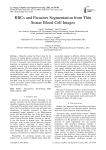
RBCs and Parasites Segmentation from Thin Smear Blood Cell Images
Статья научная
Manually examine the blood smear for the detection of malaria parasite consumes lot of time for trend pathologists. As the computational power increases, the role of automatic visual inspection becomes more important. An automated system is therefore needed to complete as much work as possible for the identification of malaria parasites. The given scheme based on used of RGB color space, G layer processing, and segmentation of Red Blood Cells (RBC) as well as cell parasites by auto-thresholding with offset value and use of morphological processing. The work compare with the manual results obtained from the pathology lab, based on total RBC count and cells parasite count. The designed system successfully detects malaria parasites and RBC cells in thin smear image.
Бесплатно
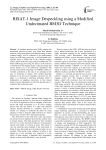
RISAT-1 Image Despeckling using a Modified Undecimated BM3D Technique
Статья научная
In synthetic aperture radar (SAR) imaging, the transmitted microwave pulses from space born antenna interacts with ground objects and returned energy or back scattered energy will be collected to get backscattered image. In SAR image processing, a not anticipated noise (speckle noise) is added due to the coherent imaging system, which makes the image analysis troublesome. For better SAR image processing, the noise is to be removed or minimized in the begging stages of pre-processing and texture features are to be effectively maintained. The wavelet based Block Matching 3D (BM3D) method is normally considered as the state of art technique in the area of denoising of images. This method generally depends on up and down sampling conversion. In this paper, it is proposed a denoising technique which is independent on sampling conversion, so that texture features can be maintained, in which the speckle noise is reduced to the maximum extent.
Бесплатно
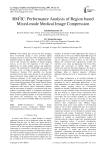
RM2IC: Performance Analysis of Region based Mixed-mode Medical Image Compression
Статья научная
The medical data science has been changing from conventional analog to more powerful digital imaging systems for some time. These imagining systems produced images in digital form. As digital technology evolves and exceeds the capability of analog imaging devices, so too does the expansion in the range of applications for image guided surgical and diagnostic systems. The optimization of bandwidth and storage are the major issues in image processing technology. The Compressive Sensing (CS) algorithm can become prominent tool for these issues because it can sample the signal with much lesser sample rate than twice of the maximum frequency of the signal and reconstruct the signal similar to the original signal. This paper, presents a novel scheme Region based Mixed-mode Medical Image Compression (RM2IC). Here, the region of interest is compressed with lossless hybrid compression methods and the non-region of interest is com-pressed with lossy hybrid CS algorithm. RM2IC is compared with different existing hybrid compression methods and it outperforms better visual perceptional quality of reconstructed image and reduces the compression rate. The performance analysis is done based on PSNR, MSE and compression ratio.
Бесплатно

